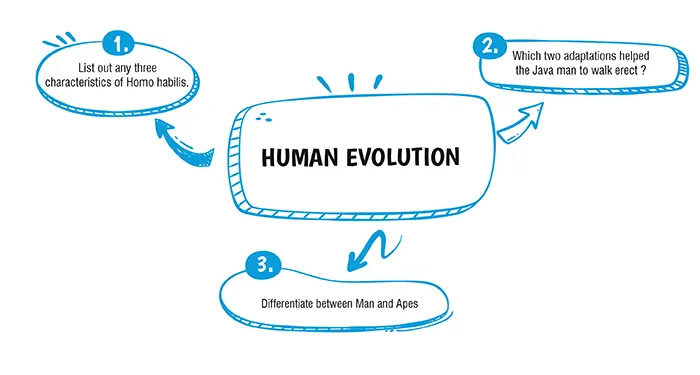Table of Contents

Ans. (a) Neanderthal man
Explanation:
Homo erectus neanderthalensis, also called as Neanderthal man evolved during the late Pleistocene epoch.
Ans. (b) 900 c.c.
Explanation:
The stage of Homo erectus lived about 1.5 million years ago. They had an average cranial capacity of about 1000 cc, significantly larger than that of early hominids.
So, it can be concluded that Homo erectus had a large brain having cranial capacity around 900 cc.
Explanation:
The characteristics are :
(i) Cranial cavity was about 735 cm3
(ii) Smaller moderately-prognathic face and smaller teeth
(iii) Showed bipedal gait
Explanation:
The two adaptations were :
(i) Modern human-like body proportions
(ii) Relatively elongated legs and shorter arms
Explanation:
| Man | Apes |
|---|---|
| Limited proportion of skin is covered with hair,. e.g.,top, back and sides of head, armpits and genitals(adults), sometimes chest and limbs (adult males). | Act usually within the same cell or at the most close to the cell. |
| Skull supported on top of vertebral column. | Skull hangs forward from the vertebral column. |
| Chemically may be proteins, steroids or amino acids. | Face is larger than the cranium. |
| Walking upright with a “bipedal gait”. | Walking with a “quadrupedal gait”. |
| Shows advanced communication and has the capacity to make tools. | Communication is limited to certain signals and gestures. |
Download Mind Map of this chapter
Download NowWant to Practice Mock Tests of this chapter
Practice NowDownload Important Questions of this chapter
Download Now| Chapter No. | Chapter Name |
|---|---|
| Chapter 1 | Structure of Chromosome, Cell Cycle and Cell division |
| Chapter 2 | Genetics: Mendel's law of Inheritance |
| Chapter 3 | Absorption by Roots- The Processes Involved |
| Chapter 4 | Transpiration |
| Chapter 5 | Photosynthesis |
| Chapter 6 | Chemical Coordination in Plants |
| Chapter 7 | The Circulatory System |
| Chapter 8 | The Excretory System |
| Chapter 9 | The Nervous System and Sense Organs |
| Chapter 10 | The Endocrine System |
| Chapter 11 | The Reproductive System |
| Chapter 12 | Human Population |
| Chapter 13 | Human Evolution |
| Chapter 14 | Pollution |
CBSE Important Questions Class 10
ICSE Important Questions Class 10
CBSE Important Questions Class 10
ICSE Important Questions Class 10